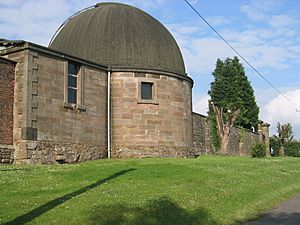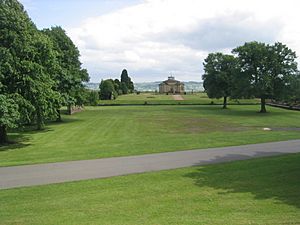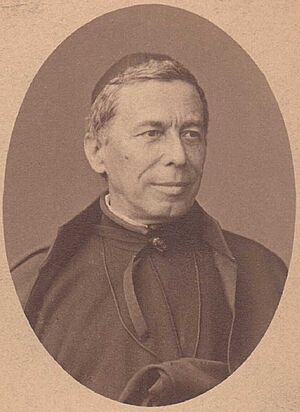Stonyhurst Observatory facts for kids
Quick facts for kids Stonyhurst Observatory |
|
|---|---|

The rear of the 1866 Observatory
|
|
| Organization | Stonyhurst College |
| Location | Stonyhurst, Lancashire, United Kingdom |
|
Coordinates
|
53°48′N 2°30′W / 53.80°N 2.50°W
|
| Altitude | 115m / 377 feet |
| Weather | Average temperature: 8.4°C |
| Established | 1838 |
| Website https://www.stonyhurst.ac.uk |
|
The Stonyhurst Observatory is a special place at Stonyhurst College in Lancashire, England. It's a working observatory and a weather station. Built in 1866, it took the place of an older building from 1838. That first building is now used for printing.
The observatory has been recording temperatures since 1846. These are some of the longest daily temperature records in the world! Only the Old Stockholm Observatory in Sweden has older records, starting in 1756. Since 2004, Stonyhurst has been one of the main weather stations used by the Met Office. This office collects important temperature data for central England.
For a long time in the 1900s, the observatory wasn't used for looking at stars. After World War II, its telescope was even sold. But later, the College managed to buy it back. Now, the telescope is safely back in its original home. You can see a picture of the old telescope here: Stonyhurst Refractor.
Today, a Classics teacher named Fintan O'Reilly runs the observatory. He also teaches astronomy to students. Sometimes, visitors can even get a special tour of the observatory.
Contents
What is the History of Stonyhurst Observatory?
The Stonyhurst Observatory first opened in 1838. Its main job was to be a weather station. In 1854, when the Met Office was created, Stonyhurst became one of the seven most important weather stations in the UK.
The observatory was run by Jesuit priests who also taught at the school. In the mid-1800s, Fathers Weld, Perry, and Sidgreaves made the observatory do even more. They started studying astronomy (stars), geomagnetism (Earth's magnetic field), and seismology (earthquakes).
How Did Stonyhurst Help with Magnetic Surveys?
In 1858, General Sir Edward Sabine chose Stonyhurst as a key spot for his magnetic survey of England. Five years later, Father Sidgreaves started regular monthly studies of Earth's magnetic field there. In 1866, he put special cameras underground. These cameras, given by the Royal Society, could automatically record changes in the Earth's magnetic field.
What Did Father Sidgreaves Discover About the Sun?
Father Sidgreaves also did important research on the Sun's light, called the solar spectrum. He wrote many papers about his findings. He took hundreds of photos of the Sun using a special tool called a spectroscope. He focused on the violet light from calcium in the Sun. Through this work, he showed that the Sun is a "variable star" in terms of its light. This means its light changes over time.
Sidgreaves also studied exploding stars called novae. In 1892, his work on Nova Aurigae included some of the first photos ever taken of a nova's light. He noticed that the light from the new star looked similar to the Sun's outer layer, called the chromosphere, which is rich in pink hydrogen light. He got similar important results from studying Nova Perseii in 1901.
Father Sidgreaves was very interested in how sunspots on the Sun were connected to changes in Earth's magnetic field. He published several papers based on his observations at Stonyhurst. From 1881 to 1898, he believed that magnetic storms were caused by clouds of charged particles moving from the Sun to Earth.
Today, we know he was right! Solar flares and mass ejections from the Sun can hit Earth's magnetic field. This causes magnetic storms. These storms are very important because they can disrupt power grids and damage satellites that help with communication.
Who Was Angelo Secchi?
In 1848, an Italian astronomer named Father Angelo Secchi visited Stonyhurst. He was from the Collegio di Romano Observatory in Rome. He stayed at Stonyhurst to avoid some political troubles in Italy. It seems that Stonyhurst's strong interest in astronomy, especially in observing the Sun, came from his time there.
What are Stonyhurst Heliographic Coordinates?
The 'Stonyhurst System of heliographic coordinates' is a way to find the exact location of features on the Sun's surface. Think of it like latitude and longitude on Earth, but for the Sun!
In this system, the starting point (zero) is where the Sun's equator crosses the middle line as seen from Earth. The longitude numbers get bigger as you go towards the Sun's western side. If something is on the Sun, its latitude stays the same as the Sun spins. But its longitude will change as it moves across the Sun's face. This is different from another system called the Carrington heliographic coordinate system, where the longitude stays mostly fixed. These coordinates are named after Stonyhurst College because they were created there in the 1800s.
What are Stonyhurst Disks?
A 'Stonyhurst disk' is a tool used to figure out the longitude and latitude of sunspots. The Earth doesn't orbit the Sun exactly around its equator. So, throughout the year, the center of solar pictures moves up and down a little. This angle changes like a wave and is called B0. The Earth crosses the Sun's equator around December 7th and June 7th each year.
This means that the lines of latitude on the Sun don't look like straight lines from Earth. Instead, they look like curved shapes called ellipses. Sunspots move across the Sun's face along these curved latitude lines. Stonyhurst disks are clear overlays that fit perfectly over full pictures of the Sun. They help you easily find sunspots by matching them to the lines of latitude and longitude on the disk. Different disks are made for different dates throughout the year.
Images for kids






